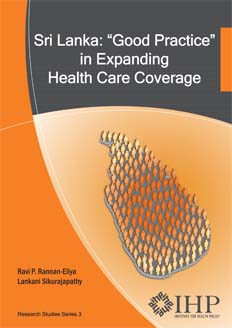The Sri Lanka case of the World Bank study was carried out by the Institute for Health Policy, and published together with the other country cases in “Good Practices in Health Financing: Lessons from reforms in low- and middle-income countries”.
Abstract
Sri Lanka, a rainy, 66,000-square-kilometer island in the Indian Ocean near the equator, is in the South Asia Region of the World Bank. Only 15 percent of Sri Lanka’s 20 million people live in cities. It is a lower-middle-income country, with GDP per capita of US$965 in 2004. The expansion of health care coverage in Sri Lanka, with its focus on the poor, dates from the 1930s, and many of the initial motivations continue to be important influences. By far the most important one for health services has been democracy. In the 1920s, conditions in the island were much like those in most other British colonies. Government intervention in health was limited to providing health care to a small urban population that operated the colonial infrastructure and administration and an equally small workforce involved in export agriculture, and to a sanitary regime designed to control major epidemic threats such as cholera. Democracy based on universal suffrage was introduced in 1931 expressly to em-power the poorer groups in society and women and to put pressure on the elites to pay closer attention to social and health conditions. After 1931, the political economy of the island changed irrevocably as the political power base shifted from urban residents to the majority rural population. The impact of democracy on health was accentu-ated by the emergence of competitive politics along a left-right dimension with two-party competition well embedded by the late 1950s, a rural bias in the delimitation of electorates where each national legislator typically represented fewer than 10,000 voters in the 1930s, and a single-member constitu-ency system that encouraged politicians to engage in parish-pump politics to maximize the government infrastructure built in their districts. The introduction of democratic politics forced successive govern-ments to continuously expand free public health services into rural areas where voters wanted the same standards established earlier for the urban population. Once democracy had served to establish a widely dispersed government health infrastructure, accessible by all, it then acted to ensure its survival under often difficult fiscal conditions. Subsequently, successful market-oriented and reform-minded governments in Sri Lanka have generally understood that the cost of adequate public sector health services accessible to the poor was a small fiscal price to pay for the political support that they engender to enable other more important economic reforms.
* Published with permission from the World Bank.

